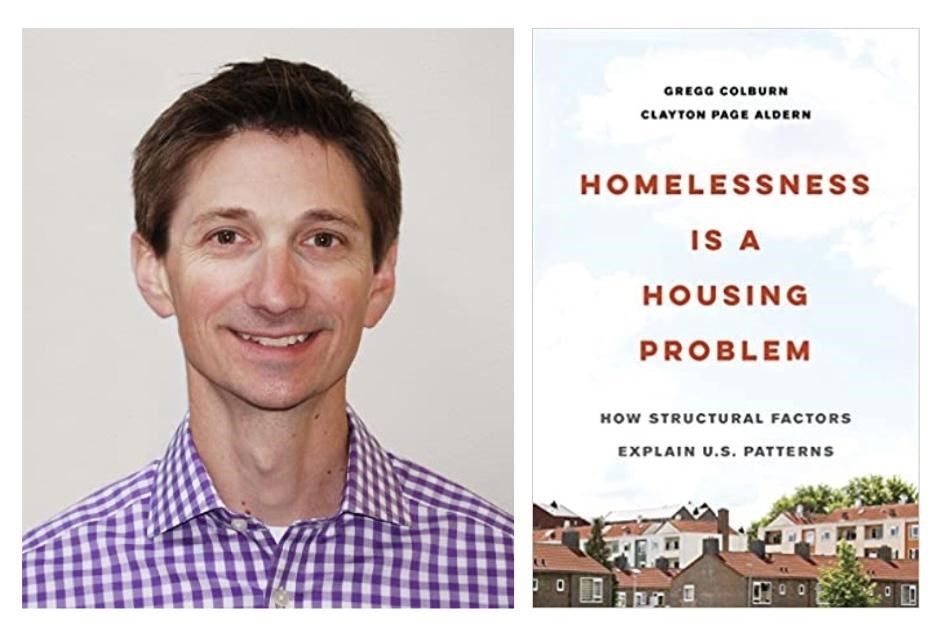By To the Point Collaborative for Council for the Homeless
 Gregg Colburn PhD is the keynote speaker for our annual “Making Home Possible Luncheon” happening October 20, 2022. In his recently released book, Homelessness is a Housing Problem, Colburn and his research partner Clayton Page Aldern, ask “Why do rates of homelessness differ from community to community?” and “What role does the availability of affordable housing play in solving homelessness at both an individual and community level?”
Gregg Colburn PhD is the keynote speaker for our annual “Making Home Possible Luncheon” happening October 20, 2022. In his recently released book, Homelessness is a Housing Problem, Colburn and his research partner Clayton Page Aldern, ask “Why do rates of homelessness differ from community to community?” and “What role does the availability of affordable housing play in solving homelessness at both an individual and community level?”
Colburn recently sat down with us to discuss his research, the main takeaways from the book, and how a community’s response to homelessness must include affordable housing.
To hear more from Colburn, register for the event today!
Q) What do you want people to take away from your research?
A) I hope people take away from our research that a failure to center housing access in the conversation around homelessness will undermine our collective efforts to end this crisis.
If we can center housing in our conversations around homelessness, I think that gives us the greatest chance of putting a dent in this growing crisis that’s in a lot of our cities. The inverse is also true, which is the failure to center housing in these conversations will likely keep us on a path that we’ve already been on, which is the continued growth of homelessness because, without proper housing, I just don’t see us being able to end this crisis, unfortunately.
We demonstrate in the book over and over that homelessness is not driven by the composition of people who live in that community and the individual challenges they may face. If you happen to live in a community, like many in Washington where housing is expensive and vacancy rates are low, we as a whole need to respond. A response that centers solely on human services will not work. This does not mean do away with emergency shelters and supportive services. It means that to make the most of the emergency services, we need to center housing in the larger conversation and ensure that we are taking the steps both from a regulatory, land use, as well as a policy-making standpoint, so that people can get access to permanent housing. Failure to do so will ensure that we will continue to struggle to address homelessness in our communities.
Q) For people who aren’t as data-driven, what would you say is the main takeaway from the book?
A) Community members will see someone experiencing mental illness on the street, who’s also experiencing homelessness, and they obviously equate the two things. The point of the book is to really highlight with data that there are people with vulnerabilities, or risk factors, for homelessness in every community in the country.
There are people experiencing homelessness, poverty, and addiction in every city in the country. When you actually look at the data on this, it’s not that more people who are poorer, addicted, or mentally ill are in Vancouver, Portland, and Seattle than in other places. In fact, in many cases, we have fewer poor people, but we have more homelessness. Why? Because housing is really tough to get. It’s not the composition of people in a community that drives rates of homelessness. It’s not “who’s there.” It is the context in which that happens, and the context is the housing market.
Q) How can organizations like Council for the Homeless and its partners make contributions, or continue to make contributions, to create more housing?
A) I think raising awareness of the link between housing availability and homelessness is absolutely essential. The advocacy and awareness role that the Council plays is incredibly important. Coordinating best practices with prevention and emergency homeless services is critical as well.
A lot of people in the academic field, as well as in the public sector, think about housing and homelessness as two separate things. But they’re not. They are directly related. We can’t separate these issues and think about housing, independent of homelessness, because if we don’t have enough housing, we’re going to have homelessness. In fact, this is a structural issue, and the lack of housing is creating this issue.
